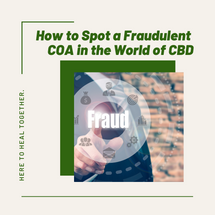Posted by Happy Trails on Jan 16th 2024
How to Spot a Fraudulent COA in the World of CBD

Why Fake a COA?
What if we told you that there are people out there faking COA’s? Scary thought right? We are here to help you spot a faulty COA but first, let’s talk about why someone would even want to do this.
Because the hemp industry is still fairly unregulated, there is no one stopping people from falsifying information. People can do this for many reasons, the main one is simply: to make more money. Increasing the percentage of a particular cannabinoid, like CBD, even by a point, will increase the worth of the product. We have seen people alter the THC content as well, claiming there is far less THC than there really is, or none at all. Here are some things to be aware of when looking over a COA.
Things to Know
It is important to get educated on cannabis in general to understand normal percentages and ratios of cannabinoids. For example, if a COA claims that there is 10-12% CBD in a strain of hemp flower and non-detect THC, you would question it because there are no strains (to our knowledge) with that high of a percentage of CBD but no THC whatsoever. If you plan to be a regular consumer, it would help to do some research on the cannabinoid profile of various strains of hemp you enjoy. But, we know that’s not always realistic in the busy world we live in. If you need help, just ask us!
Sometimes, labs don’t even realize they are producing misleading test results. Another issue that has presented itself in terms of valid COA’s is something called the limit of quantification.
Limit of Quantification (LOQ)
The limit of quantification is a term that describes how low of a value a machine can detect. For example, some labs have machines that detect various cannabinoids down to .001%. Other labs may have higher limits of quantification, say 2.00%. This means anything below this limit will give the result of being “undetected”. This is important to understand especially when it comes to THC in hemp, where the legal limit is 0.3%. If the limit of quantification at a particular lab is 2.0%, THC that is in amounts higher than 0.3% but below 2.0% would be considered undetected. The problem here is that the THC in your product could be above the legal limit, and it could really affect someone that is sensitive to THC or trying to avoid it altogether.
Most COA’s state their limits of quantification. If you see higher limits of quantification, go ahead and question that brand and ask them for more information. Next, let’s talk about other items to look for in a legitimate COA.
Photos Are Important
It may seem minuscule, but something as simple as having a photo of the product the COA is an easy, straightforward way to validate a COA. Not every COA will have a photo, but it’s a simple way to confirm that the product in the photo matches the product being analyzed.
Equations
COA’s from honest labs will be straightforward and the equations they use to derive their calculations should be clear as well.
QR Codes
If there is a QR code, scan that puppy right away. If you can trace it back to the lab that is listed on the COA, there is a high chance that COA is valid. If you have a PDF file and a printed COA, make sure they are exactly the same and trace back to the same lab.
Conclusion
COA’s in the world of CBD are important documents from a third-party lab that tell us about the purity and composition of the product we are interested in, among many other details. Sometimes, people falsify information on COA’s in their best interest in order to sell more of their product, and sometimes the information is misleading due to the limit of quantification.
We realize it’s not everyone’s job to read a COA, but we always want what’s best for our customers, and in our eyes that is education. We are always here if you have a question about a particular product and its COA!
Sincerely,
The Happy Trails Team
References:
Bennett, Theresa. “How To Pick Out Fraudulent and Misleading COAs: Q&A with Kia Mikesh of Adams Independent Testing.” Hemp Grower, Hemp Grower, 8 May 2020, www.hempgrower.com/article/how-to-pick-out-fraudulent-false-misleading-coas-hemp/.


